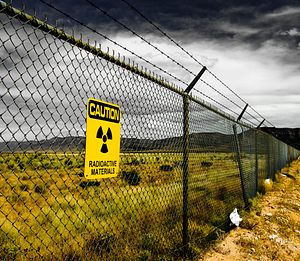On Monday a major public inquiry (known as a Royal Commission) was delivered to the South Australian state government. This report included the recommendation that the state pursue plans house a nuclear waste storage facility for waste generated by other countries.
The report concludes that the South Australian state would generate over $100 billion in revenue above expenditures over the 120 year period. It recommends that this revenue be invested in a state wealth fund that could produce up to $445 billion in revenue for the state of 1.6 million people.
The premier of South Australia, Jay Weatherill, has indicated his support for the proposal, stating on Monday that: “The Royal Commission has found that it is both safe and viable to pursue a used fuel waste storage facility, and this would have extraordinary economic benefits for South Australia.”
He further added that “[the] report provides a substantial evidence base for South Australians to consider, and marks the start of a very important conversation about the future of our State.”
It is this “future of the state” that had made this report so significant. South Australia is currently suffering from issues stemming from the wavering viability of its major industrial and manufacturing industries, and subsequent unemployment increases and demographic decline. Attracting major new industries to the state has become vital.
However, there are a number of factors beyond a massive new investment in the state that give this potential project credibility.
With large amounts of nuclear waste held in temporary storage facilities in various global locations, and with a variety of standards and procedures, there is greater potential for accidents, as well as significant security concerns over the potential for misuse. This could involve a crude dirty bomb, or even a sophisticated nuclear weapon in the right hands.
Nuclear waste is a key component in the creation of nuclear weapons. When this waste is reprocessed to separate out the uranium and plutonium from the other waste materials, the remaining plutonium can then be reused for these weapons (a reprocessing capability is something the United States has been trying to prevent Iran from obtaining).
This makes a highly remote and secure location for nuclear waste storage, like outback South Australia, a desirable option to limit the potential for waste to be siphoned off.
Furthermore, South Australia lies in the center of the Indo-Australian tectonic plate, and as a result has extremely low-levels of seismic activity, making an occurrence like the Fukushima disaster in Japan highly improbable.
Because of the remote nature of inland South Australia the area has previously been used as a site for nuclear activity.
Between 1956 and 1963 the British government conducted seven nuclear tests at Maralinga and Emu Field. The two major tests conducted were known as Operation Buffalo and Operation Antler, and were followed by other smaller tests. It was admitted by the British government in 2001 that they had used Australian troops during these tests in radiation experiments.
In 1967 an initial clean-up of the sites was conducted, however the 1985 McClelland Royal Commission investigation into the testing found this to be insufficient and ordered a second cleanup that was concluded in 2000. In 1994 the Australian government paid $13.5 million in compensation to the local indigenous Maralinga Tjarutja people due to the effects of the tests.
A public sentiment that remains aggrieved at these tests may prove a great hurdle for the South Australian government to overcome, even with the support of both major political parties.
Beyond this, the report opens up a number of issues concerning Australia’s relationship to nuclear material. One of the further recommendations of the report was the Australia should pursue nuclear power in order to reduce its carbon emissions. Australia currently has no nuclear facilities generating electricity.
Opposition to this recommendation may come from a wide range of groups. The powerful coal and gas industries would undoubtedly deem this a threat to their interests, and these industries will find themselves an unlikely ally in the Australian Greens, who have a policy of opposing all nuclear energy generation, as well as the mining of uranium.
As Australia has the world’s largest uranium resources, with around 31 percent of known deposits, there is a significant logic to it pursuing nuclear power generation. Despite these resources, Australia is only the third largest producer of uranium (behind Kazakhstan and Canada), indicating it has reserves to spare.
However, this economic rationale is countered by moral concerns about the spread of nuclear material for the use in weapons.
While Australia has safeguards in place to ensure that no uranium it sells is used in the production nuclear weapons, this merely frees up nuclear weapons states to redirect uranium bought from other sources to be used in this capacity.
A nuclear waste storage facility on Australian territory would create a significant shift in Australia’s nuclear thinking. There are signs that movement in this direction may already be occurring. One of the factors generally accepted for Australia’s recent purchase of the French designed submarines is the ease in which they can be converted to nuclear power.
As a country that believes itself to be under the U.S. nuclear umbrella, Australia already accepts the idea of nuclear weapons as a deterrent. Should these recommended proposals be enacted, what may follow is an entire rethink of Australian nuclear policy.

































